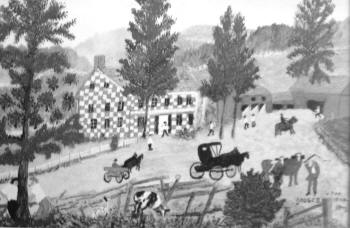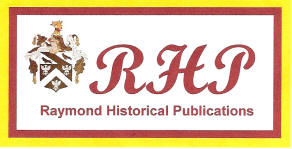|
|
|
Last time: After the Battle of Wallomsac and the Battle of Bemis Heights (sure, the carriers were the USS Bennington, CVA-20, and the USS Saratoga, CVA-60); and after new legal tracts were launched—including the NY State Constitution (April 1777) and the national Articles of Confederation (Nov. ’77)—the tide seemed to turn toward an Independence with staying power (that, of course, was CVA-62, another Vietnam era flattop.)
Chapter 13: The Revolution, Endgame – 1780-1785 The 1770s closed with a shudder for the Revolutionaries who suffered a major loss 900 miles south of Cambridge at Charleston, South Carolina. While the British failed to capture that city in ‘76, they succeeded four years later when Gen. Henry Clinton showed up with a naval squadron and 14,000 soldiers. The entire 5,400-man force of American Gen. Benjamin Lincoln (no, not Abe’s ancestor) surrendered in 1780 after a long and valiant struggle. The Siege of Charleston would become the single greatest defeat of the War for the Patriots and included the imprisonment, but thankfully not the execution, of three signers of the Declaration of Independence. Yet new heroes immerged, including Francis “the Swamp Fox” Marion and Thomas Sumter, who successfully badgered the Brits out in the boondocks. A decisive victory for the American Southern Campaign was finally realized in January of ’81 in rural SC at the Battle of Cowpens. Brig. Gen. Daniel Morgan commanded that turning point for the eventual recapture of Charleston. But the Limeys—it finally dawned on the Royal Navy in the late 1700s that citrus would abate scurvy—maintained control of the City of Churches as late as December of 1782. A year earlier, though, a major Redcoat army was chased north across the Tar Heel state into southern Virginia, to face the seminal campaign of the War in October 1781. Once on the James-York peninsula the English were hemmed in by the Continentals and a French legion on the mainland, and the French Navy commanding the Chesapeake, preventing His Majesty’s fleet from providing relief or retreat. Gen. Charles Cornwallis was forced to lay down his arms at Yorktown, muttering the famous lament “The world turned upside down” (from a century-old English tune, in turn from Book of Acts 17:6). This effectively ended the American Revolutionary War. Gen. Lincoln was honored by George Washington when asked to receive the sword of surrender. The loss of American lives was never determined but likely many tens of thousands, at least half due to disease and starvation. While all this was going on away down South, back up in our neck of the woods in 1781 a legislature of Vermonters—led by the rabble-rousing Ethan Allen and his surly Green Mountain Boys—gathered to discuss independence from the USA. Delegates from the Cambridge area attended. The issue was hotly debated. Words like New Hampshire’s “Live free or die” were countered by “What ingratitude!” For one thing, Vermont, a geographic province of sparsely populated virgin woods and ponds, ridges and hollows between the Connecticut River and Lake Champlain, was isolated from the St. Lawrence and lacked direct access to the sea, vital for independent commerce. Separation was only marginally entertained by the locals, so by ‘82 the folks of the Cambridge Valley successfully petitioned to remain in New York State. Bennington and Burlington went their own way for the time being. Meanwhile back down in the bug-infested Southern woods, English regiments hung on well into 1782, even though word of the Yorktown surrender the year before had reached their camps. So Washington’s second in command, Gen. Nathaniel Greene, flushed them out of the bushes like so many pheasants, and harried them back into Savannah and Charleston where they boarded Royal frigates and returned to a less-than Merry Old England. That year Gen. Washington commissioned the first Purple Heart, at the time a “badge of military merit” and awarded to only three, Sgt. Elijah Churchill (Battle of Long Island, 1780); Sgt. William Brown (Yorktown, 1781); and Sgt. Daniel Bissell (behind enemy lines, 1781-82). It was discontinued but revived in 1932 (GW’s 200th birthday), today awarded for combat wounds, including for a select group of extraordinary Cambridge veterans. It took another year to fashion the details but by September 1783 the Second Treaty of Paris was inked, waxed and sealed. In November the last of the Redcoats in America departed NYC, along with Sir Andrew Elliot, the 41st and final British governor of New York Province. Recall it was one hundred years since the first was installed, in 1683 when the Dutch were tossed from New York. England at long last granted the USA full sovereignty, as the sun peaked on a British Empire that had spanned the globe for 200 years. In fact, we’re the only nation in history to win separation from the Crown through bloody warfare. With the Brits departed, in early December 1783 Washington bid farewell to his officers in Fraunces Tavern in NYC (still standing today on Pearl Street), and two days before Christmas he resigned his Commission before Congress: Happy in the confirmation of our independence and sovereignty, and pleased with the opportunity afforded the United States of becoming a respectable nation, I resign with satisfaction the appointment I accepted with diffidence—a diffidence in my abilities to accomplish so arduous a task, which however was superseded by a confidence in the rectitude of our cause, the support of the supreme power of the Union, and the patronage of Heaven. What’s this, a founder officially invoking God, blurring the line between church and state?! When the treaty was ratified by the Continental Congress in January 1784, the Colonists were no longer subjects of the King, of course, but full-fledged American citizens. “So now what?” echoed across the land. After decades of broadsides, pamphlets and weeklies one major step was the establishment of the nation’s first daily paper, the Philadelphia Evening Post, which institutionalized a free press to serve as an unfettered monitor of the new experiment of Western democracy. A guiding precept would be separation of news from opinion, a “wall”, if you will—to borrow the term coined by Thomas Jefferson on the other matter. Seems a lesson today lost on the major dailies and network news who’ve hijacked traditional journalism with overwrought political correctness while mocking professional ethics in their skewed reportage of a particular party, all in the name of shilling a buck and a vote. (If they appear fair and balanced, the Brooklyn Bridge is for sale.) In the post-Revolution 1780s, the U.S. made its mark in the world of science and technology, and popular culture. Jefferson, Ben Franklin and others pioneered mechanical and electrical gadgetry in optics, replication and the like, ideas with us today. Charles Willson Peale, patriarch of a renowned American family of artists and naturalists, examined mastodon bones from the Ohio River valley and opened the nation’s first natural history museum in Philadelphia; Jefferson also emerged as an important patron of America’s natural resources, living and extinct. In 1783 Washington Irving was born in NYC; from his inkwell would flow American classics in flights of fantasy from high in the Catskills to down in the sleepy hollows of the lower Hudson valley. The first Cambridge area schoolhouse of record was constructed in 1783 at White Creek. That year James Cowden remodeled his large log cabin, his Cowden’s Tavern, with external clapboarding and a distinctive black-and-white checkerboard design. In 1858 the building would be repainted with a red-and-white pattern, but in 1907 it was accidentally reduced to ashes. Yet by 1950, one Anna Mary Robertson Moses captured the memory of many an older resident to give us her signature oil, “The Old Checkered House in Winter”, of which she actually did several different iterations of the subject (see the example.)
In the 1780s the American government was on the move. The Congress vacated Philly for a time, convening for two years, 1783-84, in Maryland at the 1772 Statehouse in Annapolis (in use today by that state’s legislature.) In 1785, NYC became the nation’s first federal capital, and for a time the seat of New York State was also there, but it moved frequently, first to Kingston, then Poughkeepsie and Hurley, and finally Albany by 1797, the nation’s second oldest state capital, i.e. since New Holland, 1624 (after Santa Fe, NM, 1610.) The District of Columbia was first conceived in 1785 for the swampy banks of the Potomac River, a compromise between northern and southern interests. A ten-mile square was authorized by Congress to be carved from MD and VA, tilted 45o on the map. Washington put his old surveying skills to work by sliding a 10-mile diamond up and down a chart of the Potomac to fit the existing river villages within its boundaries: Georgetown (up-river in the NW quadrant), Anacostia (down-river, SE), and Alexandria across the river (western sector); all had shipping docks and infrastructure well established. The section along the south bank was ceded back to VA (1847) as a bone thrown to the legal slavery of the day in that state, as freed blacks worked and settled only on the slave-free MD side. That was an issue that festered for decades for the inevitable, i.e. civil war rooted in the Declarative prose “All men are created equal ….” But first the men of the 1780s would have to fashion a new legal device for a federal legislature, executive and judiciary. Their representatives gathered in Philly and spoke for the folks of Cambridge, MA and Cambridge, NH; Cambridge, ME (then a part of MA), Cambridge, VT and Cambridge, MD; and other American Cambridges including our own. Because the Articles of Confederation just weren’t working out for the thirteen States in the post-war years, for their relationships with one another, and with an often feckless federal governance.
Next time: Chapter 14: The Constitution, The Lasting Law – 1786-1789 Sources: A History of the Cambridge Area (R. Raymond, T. Raymond 2010); George Washington letters; Grandma Moses estate; public domain. Note: Most of the mid-20th century aircraft carriers, the workhorses of WWII, Korea and Vietnam—named for historic battles and ships, events, leaders and ideals—have been mothballed or scrapped, including Bennington and Saratoga. A few have been turned into dockside museums and are well worth the visit: Yorktown (Charleston), Intrepid (NYC), Hornet (Alameda), Lexington (Corpus Christi), and Midway (San Diego). Today 11 active nuclear super-carriers help keep us secure and free, with three on the books for delivery in 2015, 2019, and 2023. (The author may be contacted at tmraymond4@gmail.com. |
|
CAMBRIDGE HISTORY LIVES © 2011
|


